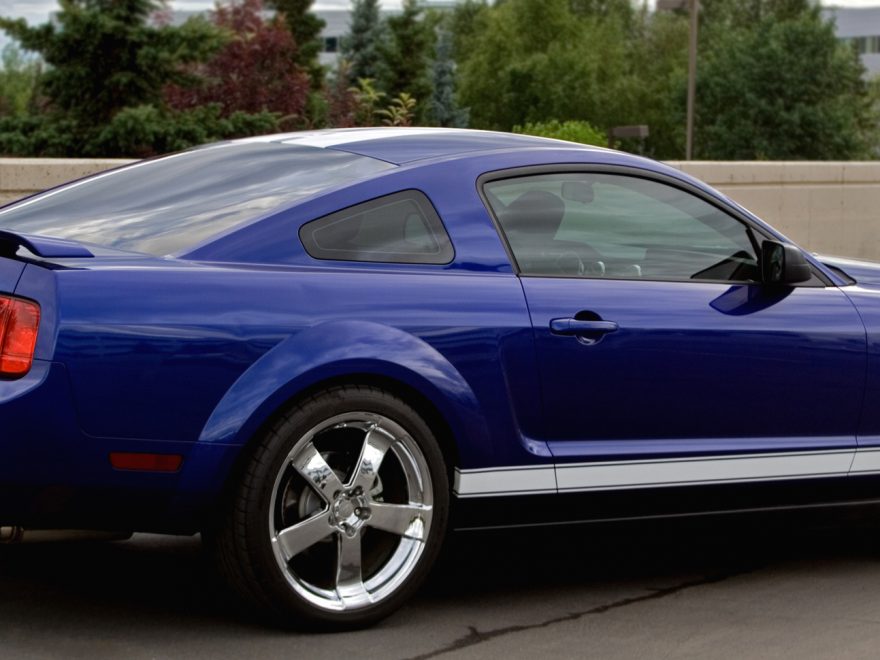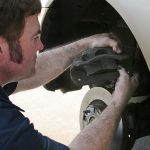According to restoration expert Willie Elder, the ’65 Ford Mustang is the most commonly rebuilt vintage car around. He should know. He rebuilt one from the ground up, including the front and back seats.
Read on for some general tips to repair or maintain the seats in a vintage Ford Mustang.
Note that the Ford Mustang Repair manual for your make may contain additional information about parts and best practices for repairing the tracks and reupholstering.
Repair or Maintain Seats in Vintage Ford Mustang?
Those of us who love vintage cars of any kind know that whenever you can, restore and maintain the original part. When it comes to seats, the three trouble areas are the seat tracks, upholstery, and the padding underneath the upholstery.
Find Your Online Car Repair Manual Today! ->>
You can often restore the tracks. Padding more often than not just needs replacing. The vinyl or leather upholstery can go either way depending on age and how well the car was cared for by the previous owner.
Tips for Repairing Broken Seat Tracks
Quite often, the seat tracks in vintage cars like Ford’s ’65-’73 Mustang need attention. Seat tracks on Mustangs from ’65-’70 are fairly similar.
Over the years, the tracks break down and don’t slide as well (or at all). You’ll need to rebuild them so that you can adjust the seat forward and back.
It takes about an hour to remove, refurbish, and reseat a pair of seat tracks. Refurbishing involves disassembling, cleaning, repainting, and lubricating the tracks. All you need is some hand tools and wheel-bearing grease.
Removing the Tracks
Use a large Phillips head bit to unbolt the screws. When you release the tracks, watch for the spring pressure. It can snap back.
Removing the Springs
You can remove the springs by hand. First stretch them out. Then remove one end form the hole. Once you have removed the screws and springs, you can remove the seat.
Removing the Seats
At the end of the tracks, you will see metal or nylon tabs. Pry those down with pliers so that you can separate the seat mounting bars from the tracks.
The mounting bars are the parts that slide back and forth. Unless something is bent or broken, the bars will separate easily.
At this point, you will be able to see if the issue is something you can fix. Or, you may need to replace with a new part.
The tabs help fall out when you separate the seat mounting bars from the tracks. There are metal bearings that will fall out as well. Be sure to keep track of them until you need them for reassembly.
Cleaning and Painting the Parts
Clean the parts with a rag and a solvent like a spray lubricant or lacquer thinner. Clean the parts thoroughly because you’ll be painting them. To paint, use flat or semi-flat black paint to refresh the look.
Reassembling
When the parts are ready, coat them with white wheel-bearing grease. As you slide the seat-mounting bars back into the tracks, replace the tabs on the seat bars, too. Next, replace the four bearings.
To finish, bend the tabs back up, then check that the seat bar moves along the track as it should. Reinstall the tracks onto the seats. Screw the seats into place, then reinstall the springs.
Tips to Install Standard Foam for Ford Mustang (1965-1966)
Even if you are planning on reupholstering the vinyl seats in your Mustang, you’ll probably find some pretty used up foam underneath. Replacing the seat foam along with the upholstery makes all the difference.
If your Mustang has the standard interior, you’ll find standard seat foam available.
Stripping the Seats
Of course, the first step is to remove the seats. Four rubber body plugs cover the nuts connecting the seats to the track. Remove the nuts with the 1/2 inch deep socket.
Fold the seats and take them from the car. Remove the four-seat track plates. Set them to the side. Disassemble the seat tracks and removed them as described above.
Note: Now would be a convenient time to vacuum and detail the interior.
Next, remove the seat back from the bottom half of the seat. You’ll need to remove two Phillips head screws from the two side panels. Use your needle nose pliers to remove the cotter pins.
Then, use your pry bar on the larger arm to separate the seat back from the seat bottom. Remove the washers behind the two arms. Remove the seat stop bolt with the 1/2-inch socket.
Unscrew the adjuster stop plate. Remove the seat back and toss it. Now that you have removed the seat back you can start cutting the hog rings along the edges.
After that, rip that old upholstery off! Though, take care not to twist the listing wire if you’re planning on keeping it. If you are going to reuse it, then cut it out of the upholstery.
Now you can rip off the foam. Cut any extra hog rings from the burlap that you may find. You don’t need to save the burlap because the new foam has protective backing. You may want to keep it, though, if it’s in good shape.
Prepping the Foam
Cut holes in your foam to accommodate the hog rings. Do this by finding the three groves on each side of the upholstery and cut through them. The holes should be just big enough for your finger to fit through.
Next, fit the foam over the seat frame. The last step it to replace the upholstery.
The next section details how to reupholster the seats.
Tips for Reupholstering Mustang Seats
From the section above, you already know how to remove the seats and separate the vinyl upholstery from the seats. Once your stripped seats have fresh standard seat foam, you are ready for the next step.
Note: If you are reupholstering with leather or New Old Stock (NOS) original material, see what installation guidelines there are for the specific material.
Replacing the foam means that you’ll have to stretch the vinyl over it for a proper fit. You may or may not have to add padding to get the fit right. You don’t want to stretch it so much that the seat will not fit between the trim panels.
Steam the vinyl to get the right flexibility and fit. As you add the vinyl, pull it over the corners. Add more padding if necessary. For the back seat, begin hog ringing around the perimeter, starting with the corners. Work toward the inside.
For the front seats, start hog ringing at the center and working outward.
Watch for wrinkles. Pull any wrinkles out with heat as you go. Redo any areas that need attention, even if it means busting the hog rings and starting over.
Caring for Leather Seats in Vintage Mustang
If you’re lucky enough to have a vintage Ford Mustang with good seats, you’ll want to keep them that way. Anytime you can preserve the original parts, go for it. Here are some tips for cleaning those gorgeous leather seats.
Before doing anything, check for perforated areas in the leather. Are there any tiny holes in the material? If so, take care to avoid those areas. Disrupting them may make them worse. Avoid getting any cleaning products or oil in the holes.
Next, vacuum the area to remove any larger particles of dirt and debris. Take care not to scratch the leather.
Use a microfiber towel and leather cleaning solution of some sort to clean the leather. If needed, use a soft-bristled brush to work additional dirt out to the surface gently.
The final step is to wipe the seats dry and go for a ride.
Ready to Repair or Maintain Seats in Vintage Ford Mustang?
The mechanics involved in Mustang seats are simple. The hardest part is applying the patience and willingness to start over when it comes to reupholstering the seats.
In the end, you will have a style as well as comfort when it comes to riding in your much-loved vintage Mustang.







